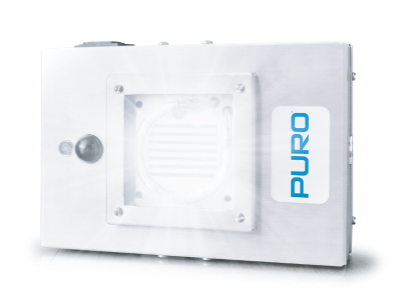Single patented UV Light Engine with transmissive UV lens and pulsed Xenon lamp.
HELOTM Units
UV Disinfection From Above
The first known miniaturized, high-intensity, full-spectrum pulsed Xenon UV disinfection fixture to be installed in the ceiling or on a wall. Helo fixtures provide unparalleled whole-room surface and air disinfection in any size space, along with the ability to disinfect on demand in one cycle.


The Helo units disinfect a whole room, delivering disinfection from above.
The units can be ordered for installation in a drop-in grid ceiling, recessed in a hard-lid ceiling, surface or wall mounted, or used as a portable, tabletop unit.
They emit broad spectrum UV light to eliminate up to 99.9% of the bacteria, viruses, and fungi in a space.1 In rooms that have been cleaned of mold, the unit will help control return growth if used routinely.2

Helo F1
- Broad Spectrum UV-C, UV-B and UV-A light to kill bacteria and viruses.1
- Ceiling or wall mounted installation to disinfect a whole room without relocation.
- Programmed manually or integrated into building automation systems through BACnet.
- Single UV Light Engine with pulsed Xenon lamp for up to a 10’ x 10’ ft coverage area.

Helo F2
Dual patented UV Light Engine with transmissive UV lens and pulsed Xenon lamp.
- Broad Spectrum UV-C, UV-B and UV-A light to kill bacteria and viruses.1
- Ceiling, suspended, or wall mounted installation to disinfect a room without staff assistance.
- Programmed manually or integrated into building automation systems through BACnet.
- Dual UV Light Engine with pulsed Xenon lamp for up to a 12’ x 12’ ft coverage area.
Get a Free Consultation
Our UV disinfectant Lighting Experts will find a solution that is right for your business.
Contact us today!- Independently validated to kill up to 99.9% of E. coli, MRSA, Salmonella enterica, Norovirus, human coronavirus 229E, C. diff and C. auris
- Research Journal of Microbiology, 2 (1), 42-49, 2007; Mycological Research, Vol. 92, Issue 3, 1989